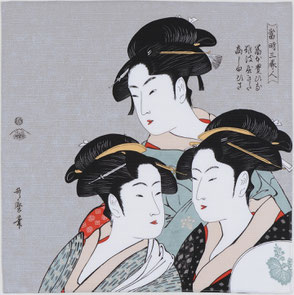🔸48 cm ukiyo-e
The designe are based on the woodblock prints "Ukiyo-e" by Katsushika Hokusai, Kitagawa Utamaro, Utagawa Hiroshige and Toshusai Sharaku. Ukiyoe is one of the traditional arts of Japan. having a great influence overseas in the late 1900s.
These prints add a touch of Japanese style to any room and would make an ideal and affordable gift for someone with an appreciation of Japanese art!
Art.No.2)
"The Great Wave Off Kanagawa”
from the series 36 Views of Mt.Fuji
by Hokusai
It is one of the most iconic works of Japanese art, The breathtaking composition with the cresting wave and Mt.Fuji express both stillness and movement. The eminent European musician Debussy and artist van Gogh were inspired by the this work.
Art.No.3)
”Kajikazawa In Kai Province" Blue
from the series 36 Views of Mt.Fuji
by Hokusai
This is considered to be one of Hokusai’s masterpieces. The composition is organized by the careful repetition of two triangular shapes. The fishing lines and the bluff form a triangle which echo the other one formed by the outline of Mt.Fuji.
Art.No.6)
"The Actor Otani Oniji III - as Edobei"
by Sharaku
The majority of the works of Sharaku (his real name is unknown) are portraits of actors or scenes from Kabuki programs. The name of actor is Otani Onji playing the roll Servent Edobei. The tightly closed mouth and the open hands shows us the actors energy and dynamism.
Art.No.8)
"Morning view at Nihonbashi" by Hiroshige
This is the first in the series “Fifty-three Stages of the Tokaido” It depicts the scene in the morning at Nihonbashi bridge in Edo (Tokyo) period. In former times Nihonbashi was considered the hub of the country, and all distances in Japan were measured from it. Even today the bridge still exists in a modern form.
☆ 48cm UKIYO-E Furoshiki
48cm Furoshiki featuring with iconic Ukiyoe artworks. Made of cotton shantung with elegantly pearl luster.
48 cm Furoshiki mit ikonischen Ukiyoe-Kunstwerken. Aus Baumwoll-Shantung mit elegantem Perlenglanz.
Variation:
No.1) The Red Fuji / Hokusai - blue
No.2) The Greate Wave off Kanagawa /Hokusai - beige
No.3) Kajikazawa In Kai Province / Hokusai - blue
No.4) The Three Beauties / Utamaro - taupe
No.5) Woman blowing a Glass Toy /Utamaro - sand
No.6) The Actor Otani Oniji III / Sharaku - gray
No.7) Cats - Tokaido Road / Kuniyoshi - beigepink
No.8) Morning view at Nihonbashi / Hiroshige - beige
size/Größe.............. 48 x 48 cm
material/Material... cotton / Baumwolle
made in Japan
care/Pflege............. hand-washing / Handwäsche
*select an Art.No.
13,95 €
inkl. MwSt, zzgl. Versandkosten
Versandkostenfrei in folgende Länder: Mehr anzeigen Weniger anzeigen
- Lieferzeit 2-3 Werktage *1 / Shipping 2-3 working days *1
*Care information: Hand Wash below 40℃, don't tumble dry, Iron on low setting if needed.
*Pflegehinweis: Handwäsche unter 40℃, Nicht Wäschetrockner, Bügeln bei niedriger Einstellung bei Bedarf.
UKIYO-E ARTIST PROFILE
Hokusai (KATSUSHIKA HOKUSAI, 1760-1849) born in Edo (now Tokyo) is the best known as author of the Japanese woodblock print, landscape series "Thirty-six Views of Mt. Fuji". Hokusai produced his very first print at the age of 19. At the beginning of his carrier, concentrated on prints of actors and beautiful women. The character of Hokusai can be best described as restless: he changed his name more than twenty times and his place of residence more than ninety times. This restlessness is also reflected in the variety of his work. Hokusai finally achieved popular success in the 1830s with his publication of landscape series "Thirty-six Views of Mt. Fuji", which was so popular that he later published 10 additional prints making a total set of 46.
Utamaro (KITAGAWA UTAMARO, 1753-1806), born in local province and went to Edo, center of Japan around 1775. It is very little known about the life of Utamaro, although there is a great deal of conjecture. Considered by many to be the greatest of the Ukiyo-e artists, Utamaro's Okubi-e ("large head" close-up) portraits of beautiful women marked an epoch in the evolution of "bijin-ga" (pictures of beautiful women). Rather than depicting a feminine atmosphere typified by clothing or surroundings, however, Utamaro tried to reproduce the beauty emphasis of the whiteness, softness and smoothness of female skin.
Sharaku (TOAHUASAI SHARAKU, ? - ?) is perhaps an unusual example among the world's great artists: He left a large number of masterpieces (mainly, portraits of Kabuki-actors) but the dates of his birth and death and details of his carrier are buried in obscurity. Unconfirmed reports state that he started out as a Noh actor employed by the lord of Awa province, and was active as a Ukiyo-e artist for only two years - 1794 and 1795.
Hiroshige (ANDO HIROSHIGE, 1797-1858) His most famous work pieces are the series “Fifty-three Stages of the Tokaido”.
The Tokaido road connected Edo to Kyoto, running along the Pacific coast. Along the route stood fifty-three post towns, each of which is depicted in this series. Hiroshige’s first journey on the Tokaido in 1832 inspired him to embark on this project. Hiroshige is also known to have had a marked influence on Western painting.
Kuniyoshi (UTAGAWA KUKNIYOSHI, 1798-1861) He was one of the last great masters of Japanese ukiyoe. He belonged to the Utagawa school. Kuniyoshi's favourite subjects cover a wide range of genres. Landscapes, pictures of beautiful women, Kabuki actors, cats and mythical animals. He is also known for his depictions of samurai battles and legendary heroes. His prints are influenced by westerns in their landscapes and caricatures. In his private life he was a lover of cats.


























